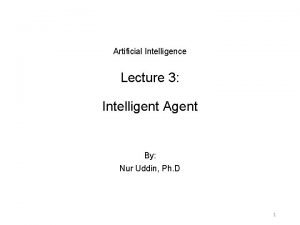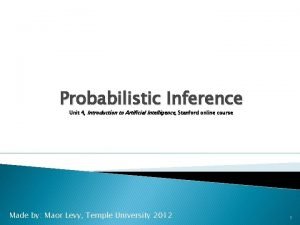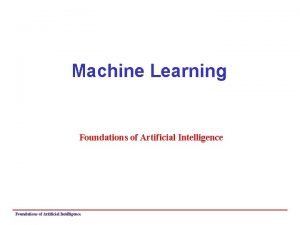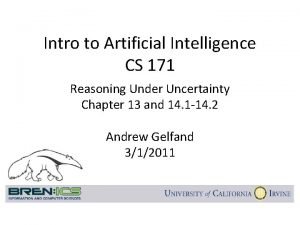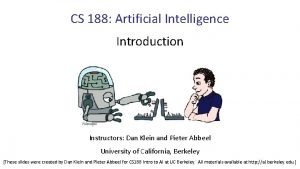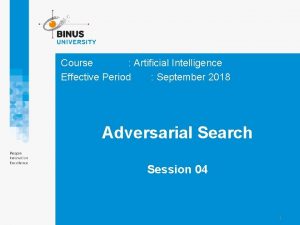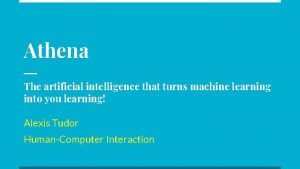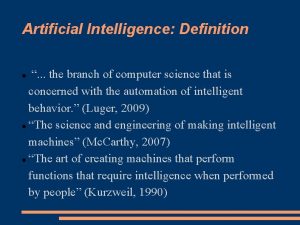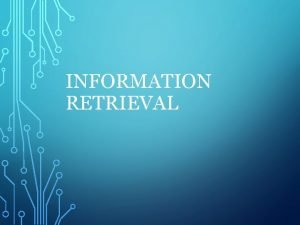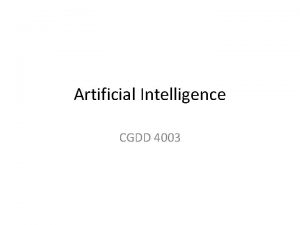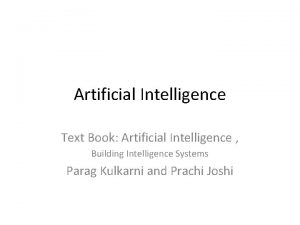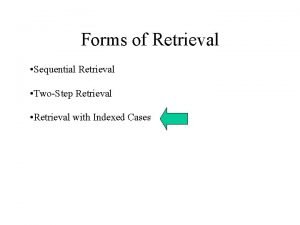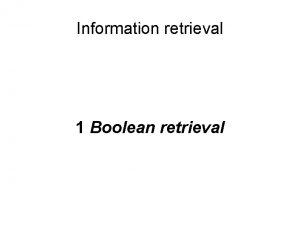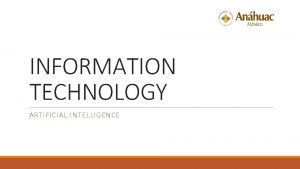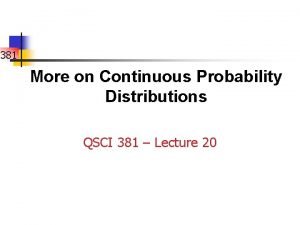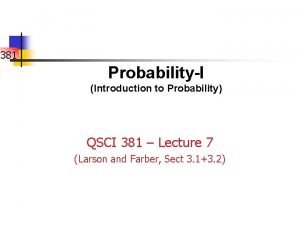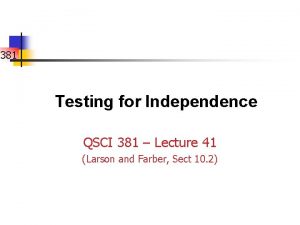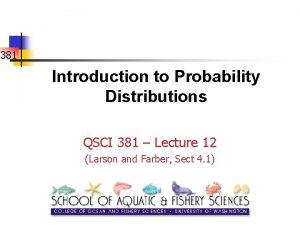15 381 Artificial Intelligence Information Retrieval How to





















![Relevance Feedback Rocchio Formula Q’ = F[Q, Dret ] F = weighted vector sum, Relevance Feedback Rocchio Formula Q’ = F[Q, Dret ] F = weighted vector sum,](https://slidetodoc.com/presentation_image/cf355cd594aa68cad5cf4441d8cd1701/image-22.jpg)
















- Slides: 38

15 -381 Artificial Intelligence Information Retrieval (How to Power a Search Engine) Jaime Carbonell 20 September 2001 Topics Covered: • “Bag of Words” Hypothesis • Vector Space Model & Cosine Similarity • Query Expansion Methods

Information Retrieval: The Challenge (1) Text DB includes: (1) Rainfall measurements in the Sahara continue to show a steady decline starting from the first measurements in 1961. In 1996 only 12 mm of rain were recorded in upper Sudan, and 1 mm in Southern Algiers. . . (2) Dan Marino states that professional football risks loosing the number one position in heart of fans across this land. Declines in TV audience ratings are cited. . . (3) Alarming reductions in precipitation in desert regions are blamed for desert encroachment of previously fertile farmland in Northern Africa. Scientists measured both yearly precipitation and groundwater levels. . .

Information Retrieval: The Challenge (2) User query states: "Decline in rainfall and impact on farms near Sahara" Challenges • How to retrieve (1) and (3) and not (2)? • How to rank (3) as best? • How to cope with no shared words?

Information Retrieval Assumptions (1) Basic IR task • There exists a document collection {Dj } • Users enters at hoc query Q • Q correctly states user’s interest • User wants {Di } < {Dj } most relevant to Q

Information Retrieval Assumption (2) "Shared Bag of Words" assumption Every query = {wi } Every document = {wk }. . . where wi & wk in same Σ All syntax is irrelevant (e. g. word order) All document structure is irrelevant All meta-information is irrelevant (e. g. author, source, genre) => Words suffice for relevance assessment

Information Retrieval Assumption (3) Retrieval by shared words If Q and Dj share some wi , then Relevant(Q, Dj ) If Q and Dj share all wi , then Relevant(Q, Dj ) If Q and Dj share over K% of wi , then Relevant(Q, Dj)

Boolean Queries (1) Industrial use of Silver Q: silver R: "The Count’s silver anniversary. . . " "Even the crash of ’ 87 had a silver lining. . . " "The Lone Ranger lived on in syndication. . . " "Sliver dropped to a new low in London. . . ". . . Q: R: silver AND photography "Posters of Tonto and the Lone Ranger. . . " "The Queen’s Silver Anniversary photos. . . ". . .

Boolean Queries (2) Q: (silver AND (NOT anniversary) AND (NOT lining) AND emulsion) OR (Ag. I AND crystal AND photography)) R: "Silver Iodide Crystals in Photography. . . " "The emulsion was worth its weight in silver. . . ". . .

Boolean Queries (3) Boolean queries are: a) easy to implement b) confusing to compose c) seldom used (except by librarians) d) prone to low recall e) all of the above

Beyond the Boolean Boondoggle (1) Desiderata (1) • Query must be natural for all users • Sentence, phrase, or word(s) • No AND’s, OR’s, NOT’s, . . . • No parentheses (no structure) • System focus on important words • Q: I want laser printers now

Beyond the Boolean Boondoggle (2) Desiderata (2) • Find what I mean, not just what I say Q: cheap car insurance (p. AND (p. OR "cheap" [1. 0] "inexpensive" [0. 9] "discount" [0. 5)] (p. OR "car" [1. 0] "auto" [0. 8] "automobile" [0. 9] "vehicle" [0. 5]) (p. OR "insurance" [1. 0] "policy" [0. 3]))

The Vector Space Model (1) Let Σ = [w 1, w 2, . . . wn ] Let Dj = [c(w 1, Dj), c(w 2, Dj), . . . c(wn, Dj)] Let Q = [c(w 1, Q), c(w 2, Q), . . . c(wn, Q)]

The Vector Space Model (2) Initial Definition of Similarity: SI(Q, Dj) = Q. Dj Normalized Definition of Similarity: SN(Q, Dj) = (Q. Dj)/(|Q| x |Dj|) = cos(Q, Dj)

The Vector Space Model (3) Relevance Ranking If SN(Q, Di) > SN(Q, Dj) Then Di is more relevant than Di to Q Retrieve(k, Q, {Dj}) = Argmaxk[cos(Q, Dj)] Dj in {Dj}

Refinements to VSM (2) Stop-Word Elimination • Discard articles, auxiliaries, prepositions, . . . typically 100 -300 most frequent small words • Reduce document length by 30 -40% • Retrieval accuracy improves slightly (510%)

Refinements to VSM (3) Proximity Phrases • E. g. : "air force" => airforce • Found by high-mutual information p(w 1 w 2) >> p(w 1)p(w 2) p(w 1 & w 2 in k-window) >> p(w 1 in k-window) p(w 2 in same k-window) • Retrieval accuracy improves slightly (5 -10%) • Too many phrases => inefficiency

Refinements to VSM (4) Words => Terms • term = word | stemmed word | phrase • Use exactly the same VSM method on terms (vs words)

Evaluating Information Retrieval (1) Contingency table: retrieved relevant a not-relevant b not retrieved c d

Evaluating Information Retrieval (2) P = a/(a+b) R = a/(a+c) Accuracy = (a+d)/(a+b+c+d) F 1 = 2 PR/(P+R) Miss = c/(a+c) = 1 - R (false negative) F/A = b/(a+b+c+d) (false positive)

Query Expansion (1) Observations: • Longer queries often yield better results • User’s vocabulary may differ from document vocabulary Q: how to avoid heart disease D: "Factors in minimizing stroke and cardiac arrest: Recommended dietary and exercise regimens" • Maybe longer queries have more chances to help recall.

Query Expansion (2) Bridging the Gap • Human query expansion (user or expert) • Thesaurus-based expansion Seldom works in practice (unfocused) • Relevance feedback – Widen a thin bridge over vocabulary gap – Adds words from document space to query • Pseudo-Relevance feedback • Local Context analysis
![Relevance Feedback Rocchio Formula Q FQ Dret F weighted vector sum Relevance Feedback Rocchio Formula Q’ = F[Q, Dret ] F = weighted vector sum,](https://slidetodoc.com/presentation_image/cf355cd594aa68cad5cf4441d8cd1701/image-22.jpg)
Relevance Feedback Rocchio Formula Q’ = F[Q, Dret ] F = weighted vector sum, such as: W(t, Q’) = αW(t, Q) + βW(t, Drel ) - γW(t, Dirr )

Term Weighting Methods (1) Salton’s Tf*IDf Tf = term frequency in a document Df = document frequency of term = # documents in collection with this term IDf = Df-1

Term Weighting Methods (2) Salton’s Tf*IDf Tf. IDf = f 1(Tf)*f 2(IDf) E. g. f 1(Tf) =Tf*ave(|Dj|)/|D| E. g. f 2(IDf) = log 2(IDF) f 1 and f 2 can differ for Q and D

Efficient Implementations of VSM (1) • • Build an Inverted Index (next slide) Filter all 0 -product terms Precompute IDF, per-document TF …but remove stopwords first.

Efficient Implementations of VSM (3) [term IDFtermi, <doci, freq(term, doci ) docj, freq(term, docj ). . . >] or: [term IDFtermi, <doci, freq(term, doci), [pos 1, i, pos 2, i, . . . ] docj, freq(term, docj), [pos 1, j, pos 2, j, . . . ]. . . >] posl, 1 indicates the first position of term in documentj and so on.

Generalized Vector Space Model (1) Principles • Define terms by their occurrence patterns in documents • Define query terms in the same way • Compute similarity by document-pattern overlap for terms in D and Q • Use standard Cos similarity and either binary or Tf. IDf weights

Generalized Vector Space Model (2) Advantages • Automatically calculates partial similarity If "heart disease" and "stroke" and "ventricular" co -occur in many documents, then if the query contains only one of these terms, documents containing the other will receive partial credit proportional to their document co-occurrence ratio. • No need to do query expansion or relevance feedback

GVSM, How it Works (1) Represent the collection as vector of documents: Let C = [D 1, D 2, . . . , Dm ] Represent each term by its distributional frequency: Let ti = [Tf(ti, D 1), Tf(ti, D 2 ), . . . , Tf(ti, Dm )] Term-to-term similarity is computed as: Sim(ti, tj) = cos(vec(ti), vec(tj)) Hence, highly co-occurring terms like "Arafat" and "PLO" will be treated as near-synonyms for retrieval

GVSM, How it Works (2) And query-document similarity is computed as before: Sim(Q, D) = cos(vec(Q)), vec(D)), except that instead of the dot product calculation, we use a function of the term-to-term similarity computation above, For instance: Sim(Q, D) = Σi[Maxj(sim(qi, dj)] or normalizing for document & query length: Simnorm(Q, D) =

A Critique of Pure Relevance (1) IR Maximizes Relevance • Precision and recall are relevance measures • Quality of documents retrieved is ignored

A Critique of Pure Relevance (2) Other Important Factors • What about information novelty, timeliness, appropriateness, validity, comprehensibility, density, medium, . . . ? ? • In IR, we really want to maximize: P(U(f i , . . . , f n ) | Q & {C} & U & H) where Q = query, {C} = collection set, U = user profile, H = interaction history • . . . but we don’t yet know how. Darn.

Maximal Marginal Relevance (1) • A crude first approximation: novelty => minimal-redundancy • Weighted linear combination: (redundancy = cost, relevance = benefit) • Free parameters: k and λ

Maximal Marginal Relevance (2) MMR(Q, C, R) = Argmaxkdi in C[λS(Q, di) - (1 -λ)maxdj in R (S(di, dj))]

Maximal Marginal Relevance (MMR) (3) COMPUTATION OF MMR RERANKING 1. Standard IR Retrieval of top-N docs Let Dr = IR(D, Q, N) 2. Rank max sim(di ε Dr, Q) as top doc, i. e. Let Ranked = {di} 3. Let Dr = Dr{di} 4. While Dr is not empty, do: a. Find di with max MMR(Dr, Q. Ranked) b. Let Ranked = Ranked. di c. Let Dr = Dr{di}

Maximal Marginal Relevance (MMR) (4) Applications: • Ranking retrieved documents from IR Engine • Ranking passages for inclusion in Summaries

Document Summarization in a Nutshell (1) Types of Summaries Task Query-relevant (focused) INDICATIVE, To filter search for Filtering (Do I engine results read further? ) CONTENTFUL, To solve problems for reading in lieu for busy of full doc. professionals Query-free (generic) Short abstracts Executive summaries

Summarization as Passage Retrieval (1) For Query-Driven Summaries 1. Divide document into passages e. g, sentences, paragraphs, FAQ-pairs, . . 2. Use query to retrieve most relevant passages, or better, use MMR to avoid redundancy. 3. Assemble retrieved passages into a summary.
 Expert system
Expert system What is state space search in ai
What is state space search in ai Searching for solutions in artificial intelligence
Searching for solutions in artificial intelligence 15-780 graduate artificial intelligence
15-780 graduate artificial intelligence Knowledge manipulation in ai
Knowledge manipulation in ai Procedural knowledge in ai
Procedural knowledge in ai Starts new page numbered sequentially
Starts new page numbered sequentially Kecerdasan kepemimpinan
Kecerdasan kepemimpinan Uas kecerdasan buatan
Uas kecerdasan buatan Math for artificial intelligence
Math for artificial intelligence Peas table ai
Peas table ai 15-780 graduate artificial intelligence
15-780 graduate artificial intelligence Xkcd machine learning
Xkcd machine learning Fuzzy propositions in ai
Fuzzy propositions in ai Asu cse 571
Asu cse 571 15 780
15 780 Informed and uninformed search
Informed and uninformed search Artificial intelligence for class 6
Artificial intelligence for class 6 Augmented grammar in artificial intelligence
Augmented grammar in artificial intelligence Omniscience in artificial intelligence
Omniscience in artificial intelligence Int404
Int404 Artificial intelligence class 8 chapter 3 solutions
Artificial intelligence class 8 chapter 3 solutions Semantic network in ai
Semantic network in ai Ao* algorithm in artificial intelligence
Ao* algorithm in artificial intelligence Artificial intelligence thesis proposals
Artificial intelligence thesis proposals Rule based deduction system in artificial intelligence
Rule based deduction system in artificial intelligence Inference by enumeration in artificial intelligence
Inference by enumeration in artificial intelligence Learning in ai
Learning in ai Water jug problem in artificial intelligence
Water jug problem in artificial intelligence Introduction to artificial intelligence and expert systems
Introduction to artificial intelligence and expert systems Optimal decisions in games in artificial intelligence
Optimal decisions in games in artificial intelligence Hbr machine learning
Hbr machine learning Cs188 artificial intelligence
Cs188 artificial intelligence Optimal decisions in games in artificial intelligence
Optimal decisions in games in artificial intelligence Athena artificial intelligence
Athena artificial intelligence Types of artificial intelligencel
Types of artificial intelligencel Using logic
Using logic Artificial intelligence is a branch of computer science
Artificial intelligence is a branch of computer science Mobedic
Mobedic



















